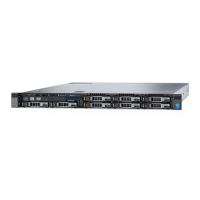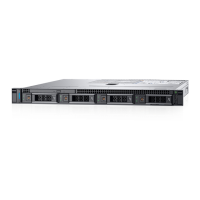Option Description
Intel(R) TXT Enables you to set the Intel Trusted Execution Technology (TXT) option. To enable the Intel TXT option,
virtualization technology and TPM Security must be enabled with Pre-boot measurements. This option is set to O
by default.
Power Button Enables you to set the power button on the front of the system. This option is set to Enabled by default.
AC Power Recovery Sets how the system behaves after AC power is restored to the system. This option is set to Last by default.
AC Power Recovery
Delay
Enables you to set the time that the system should take to power up after AC power is restored to the system.
This option is set to Immediate by default.
User Dened Delay
(60 s to 600 s)
Enables you to set the User Dened Delay option when the User Dened option for AC Power Recovery Delay is
selected.
UEFI Variable
Access
Provides varying degrees of securing UEFI variables. When set to Standard (the default), UEFI variables are
accessible in the operating system per the UEFI specication. When set to Controlled, selected UEFI variables are
protected in the environment, and new UEFI boot entries are forced to be at the end of the current boot order.
In-Band
Manageability
Interface
When set to Disabled, this setting will hide the Management Engine's (ME), HECI devices, and the system's IPMI
devices from the operating system. This prevents the operating system from changing the ME power capping
settings, and blocks access to all in-band management tools. All management should be managed through out-of-
band. This option is set to Enabled by default.
NOTE: BIOS update requires HECI devices to be operational and DUP updates require IPMI interface to
be operational. This setting needs to be set to Enabled to avoid updating errors.
Secure Boot Enables Secure Boot, where the BIOS authenticates each pre-boot image by using the certicates in the Secure
Boot Policy. Secure Boot is set to Disabled by default.
Secure Boot Policy When Secure Boot policy is set to Standard, the BIOS uses the system manufacturer key and certicates to
authenticate pre-boot images. When Secure Boot policy is set to Custom, the BIOS uses the user-dened key and
certicates. Secure Boot policy is set to Standard by default.
Secure Boot Mode Enables you to congure how the BIOS uses the Secure Boot Policy Objects (PK, KEK, db, dbx).
If the current mode is set to Deployed Mode, the available options are User Mode and Deployed Mode. If the
current mode is set to User Mode, the available options are User Mode, Audit Mode, and Deployed Mode.
Options Description
User Mode
In User Mode, PK must be installed, and BIOS performs signature verication on
programmatic attempts to update policy objects.
BIOS allows unauthenticated programmatic transitions between modes.
Audit Mode
In Audit mode, PK is not present. BIOS does not authenticate programmatic updates to
the policy objects, and transitions between modes.
Audit Mode is useful for programmatically determining a working set of policy objects.
BIOS performs signature verication on pre-boot images and logs the results in the image
Execution Information Table, but approves the images whether they pass or fail
verication.
Deployed Mode
Deployed Mode is the most secure mode. In Deployed Mode, PK must be installed and
the BIOS performs signature verication on programmatic attempts to update policy
objects.
Deployed Mode restricts the programmatic mode transitions.
Pre-operating system management applications 57

